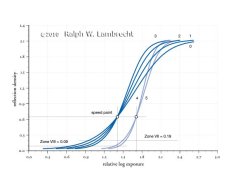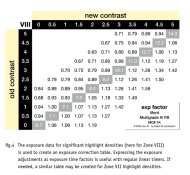Inside the box of Ilford filters (for MG papers) there is sheet of instructions. It says that all filters 00-3 and 4-5 should have same exposure. 1 stop difference between 3 and 4.
I just did a print with filter 2.5 and decided I wanted softer blacks so I changed to 2. I had to give a full stop less exposure to get same highlights.
Is this normal? Is there a one stop difference between all filters?
r
shimoda
You discovered something important here. It's the difference between the way people print and the way the paper standard is defined. Ilford's (and other filter) instructions relate to the ISO standard, which may or, more likely, may not match your way of printing.
The standard sets the speed point for papers at 0.6 density above base+fog. All filters are designed around that standard. In other words, if you overlay the characteristic curves of test prints made with filter numbers 00-3, they will all cross over at 0.6 density, and consequently, match in speed at that point. But, that's where the problem lies.
A density of 0.6 is a bit lighter than a medium gray! That's typically not a density people try to match when moving up or down in contrast. For example, I like to match the highlights at about 0.1 density. But, if you pick any other density than 0.6 to match, filters (Ilford, Agfa, Kodak and others) always need an exposure correction when changing contrast.
The way to fix this is to make yourself an exposure correction table. This will allow to move between paper contrasts without having to jump between exposure and contrast corrections.












